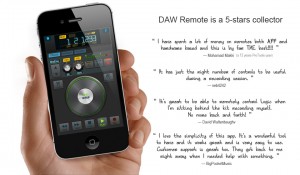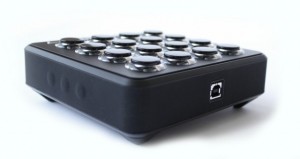Neyrink V Control Pro App For iPad Update 1.5 – Show and Tell
Russ does a show and tell of the new Neyrink V Control Pro 1.5 app for iPad. V-Control Pro provides a fully-featured, multi-touch control surface for Pro Tools, Logic 9, Cubase/Nuendo, and many more DAW’s. V-Control Pro uses WiFi to control transport, editing, and mixing functions. V-Control Pro provides advanced control of sends, automation, groups, auditioning, plug-ins, jog/scrub/shuttle, I/O assignment, and other controls within an easy-to-use interface. V-Control can be used simultaneous with ethernet controllers used by Pro Tools.
He demonstrates the new V-Window which allows control of plug-ins and other windows in your DAW from your iPad over wifi.
Analog Universe (NightBirds Electronic Music / Live in studio) 2012
Recorded live & direct in the studio with 3 cameras.
Instruments used :
RSF Kobol & Blackbox, ARP Odyssey, KORG MS-20, ROLAND System 101 & 102 (x2), ROLAND Jupiter 6.
Race against time to get everything done in one take 
Video by NightBirds.
Publication & Copyright by NightBirds Electronic Music – 2012
http://fr-fr.facebook.com/people/NightBirds-Electronique/100000038001995
http://soundcloud.com/nightbirds-electronic
FL Studio Alpha Testing | Performance Mode Options
Discuss here – http://forum.image-line.com/viewtopic.php?f=100&t=89582
FL Studio Performance Mode Alpha Testing
EUM releases ‘DAW Remote’ for iPhone
EUM is an app developer that has several apps on the market from a tuner to a metronome – all with very clean interfaces. DAW Remote is the latest addition to their line and works with Logic, Pro Tools, Ableton Live and live applications using the Mackie HUI/Mackie Control protocols.
The musician + engineer role just got a whole lot easier!
DAW Remote is a as simple as a $10 controller could possibly be while providing flexible options that any user would ever want in such an affordable app. Check the details from EUM:
“What is DAW Remote
DAW Remote is a wireless DAW(Digital Audio Workstation) software controller, especially optimized for Apple Logic, AVID ProTools and Ableton Live. DAW Remote 2.0 is compatible with both MAC and Windows.
Instead of getting stuck in front of your computer to compose, record, and produce music/audio, you can use your iPhone/iPod with DAW Remote to control DAW functions anywhere in your studio (wirelessly). Why? Because let’s face it, wires suck!
Not only does DAW Remote work for Logic, ProTools and Live, it’s also compatible with other popular DAW softwares such as FinalCut, Audition which support one of Mackie HUI, Logic Control and Mackie Control protocols.
It’s Lightweight
DAW Remote only has simple but essential functions. It’s designed for you to save your life instead of wasting time on uncountable buttons and knobs which may never been used.
It’s Wireless
DAW Remote use air not wire. You can use your DAW Remote everywhere in your studio without worrying about wires.
All about Timeline
Your notes and emotions lie on your timeline. You play and play again just to make sure everything is all right. DAW Remote is just designed to help. JOG and Scrub mode can help you to control playback quickly and efficiently.
Recording for the best!
With Punch Recording function, you can practice as many times as you like before performing the final take. This allows you to make the preceding song section to “get into the groove.
Features List
- New DAWs Support It supports Apple Logic, AVID ProTools and Ableton Live now!
- Cross Platform Compatible with MAC and Windows.
- Lightweight and well designed Essential functions to accelerate your workflow
- Track Control Record, Mute, Solo, VOL, PAN, and Track Selector
- Track Level Meter indicator.
- Markers Control Add, Delete markers. Quickly jump to previous and next marker.
- Playback Control Rewind, FWD, Play, Record, Stop
- Jog/Scrub Wheel Mode Quickly seek the right location of your song
- Punch Recording Add, Delete and Edit Circle and Punch, Easy to do recording remotely
- Zoom Mode Zoom editor/mix view remotely
- Visualized Information Display Read your Time Code, Track Name, Pan and Volume information directly.
- Other Utilities such as: Undo,Redo,Enter,Save,Cancel,Click,etc.
- Powerful Instructions Help and FAQ to help you setup connection much easier
- Use Wi-Fi to connect with host computer
- No extra drivers required”
Tom Oberheim discusses his classic Two Voice synth
Tom Oberheim’s lecture at Cal State Monterey Bay about synthesizers, particularly a little demo on his Two-Voice Synth
Oberheim’s first synthesizer was a single-voice mini-module called a SEM (Synthesizer Expander Module). However, in 1975, Oberheim created their first compact, programmable and polyphonic synthesizer by coupling two SEM modules to a 37-note keyboard and a simple analog sequencer. This was what became the Two Voice. Oberheim achieved a polyphonic sound not yet seen in ARP and Moog gear at the time by hard-wiring the two monophonic SEMs into the compact keyboard design.
In 1976 Oberheim came out with another module, the Polyphonic Synthesizer Programmer. This could memorize the control voltages of many parameters for up to eight SEM modules. When these were added to the Two Voice, Oberheim finally had one of the earliest programmable and polyphonic instruments! Released alongside the Two Voice also came the Four Voice which had four SEMs installed, and a larger 49-note keyboard. And later, in 1977, a second tier was added above the four SEMs on the Four Voice to add yet another four SEMS, making the Eight Voice.
Two voices was great in 1975, and eight voices was pretty monstrous in the later seventies. But, a major drawback to these first Oberheim synths was that polyphony was achieved by having multiple modules. This meant that each voice had to be independently programmed. This also means that each voice has its own filter, making real-time filter sweeps of all your voices more than a handful! Fortunately the sequencer comes in handy for controlling each voice/module independently.
Digital Enhancement – sound installation
“Digital Enhancement” is an interactive sound installation consisting of an electrified Symphonion Brevet No. 28, a synthesizer, an amplifier and four headphones. The Symphonion musical box dates back to the beginning of the last century and its mechanical workings are combined with digital technology to convert it into a MIDI sequencer. The original music, embossed on steel plates, can be played on the synthesizer, which is programmed to mimic the sounds of the Symphonion. In order to operate the sequencer, a hand-cranked dynamo serves as a remote control.
Additional Information:
2011, interactive sound installation, hand-cranked dynamo, micro-controller, custom electronic circuit, hardware of antique musical box, embossed steel plate, antique wooden cassette, stepper motor, hardware synthesizer, headphone amplifier, headphones, misc cables.
Project website: mar.li/digital_enhancement.php
Taking a closer look at the Casio XW-P1 Performance Synthesizer
Mike Martin from Casio visited Sweetwater Sound to give a deep overview of the XW-P1 Performance Synthesizer. Mike shows off a lot of sounds, the ability to mix oscillators on the fly, and some awesome sequencing and arpeggiation capabilities. Enjoy the demo, then learn even more about the Casio XW-P1 Performance Synthesizer right here: http://bit.ly/sw_XWP1
The Casio XW-P1 is a powerful six oscillator monophonic solo synth that is ready to gig. You can combine all six oscillators to make a single tone. You get two virtual analog style oscillators, two PCM oscillators, one noise oscillator, and one external oscillator for use with line and mic inputs. Each oscillator has their own filter, portamento, envelopes, key tracking, a master resonant filter, and two LFOs. The XW-P1 is an extremely powerful synth that lets you really edit and tweak each setting. You also have access to the original CZ synthesizer’s waveforms.
Midi Fighter 3D Controller from DJ TechTools
For more information and to preorder: http://www.djtechtools.com/2012/02/27/introducing-the-midi-fighter-3d/
DJ Tech Tolls tells us that their MidiFighter has now been released, here’s their pitch:
Today we’re very proud to usher in the newest DJTT creation: The Midi Fighter 3D controller. Equipped with 16 RGB arcade buttons and full three dimensional tracking of the controller’s movement in space, this latest addition to the Midi Fighter line is our most ambitious and expressive creation to date.
Key Features:
- Fully customizable high performance RGB arcade buttons
- 4 banks of controls
- 6 side buttons
- Optional hand strap for full instrument control
- Full 3D motion tracking of five degrees of movement (Patent Pending)
- Highly grippy rubberized feet and sleeve
- Gyroscope, Accelerometer and Compass for absolute orientation tracking.
Soundcheck – Arturia Minibrute Analog Synthesizer
Checking out the sounds of the MiniBrute:
Mini Brute is the new Arturias analog synthesizer that is, with its completely analog signal path and its innovative features set new standards.
Its multi-waveform oscillator, and the classic, hands-multimode filter will breathe new life into your recordings. Outstanding features like Ultrasaw, and brute Factor Metalizer be supplemented with a flexible arpeggiator and LFO Sample & Hold incl. The Mini Brute has extensive USB / MIDI / CV terminals and a robust metal housing.
This is the full analogue broadside!
Pre-order now in the Music Store!
www.musicstore.de
Electronic music: Jacob 2-2 / Cabazon BlipVert
Quite fascinating videos with some nice synth sounds, enjoy
Jacob 2-2 is a Brooklyn-based sound and video artist who takes his name from an obscure, late-70s movie about a fearless kid investigator. “It’s probably one of the weirdest things I’ve ever seen,” says the producer, whose first name is David but who prefers not to give his last name. It makes total sense when you listen to his music: there’s a kid-like wonder to it, crossed with a dose of playful humor and an bunch of weird 80s synths. It’s a lot like Look Around You condensed into musical form.
David’s prized possession is an old Roland Juno 6. That particular Juno has no presets at all, so every time he gets something he likes he has to record it immediately. “I always think to myself, ‘I’d better record it now or else I’ll never be able to recreate it.’” Its warm sound in turn drives his beats and effects, filled with pings and blips that could be straight from any 80s video game. Sometimes his beats are muffled, while at other times they shine through clearly.
So far, David has put out three EPs, two self-released through his Bandcamp: (The Gifted Child and Cabazon). His most recent EP, Fantasiarexia, was picked up by Jakub Alexander of Moodgadget. He’s also had a couple compilation releases and a handful of remixes for Aleph, Starfawn, Macka and others. (You can listen to all of them on his SoundCloud page.) A motion graphic designer by trade, David also makes his own videos for his live show, performing against a background of material loosely cut together to his music and full of weird and wonderful nostalgia and color.
Background info via CDM





